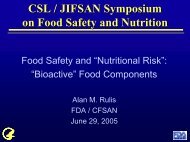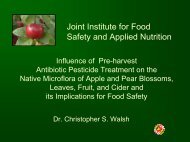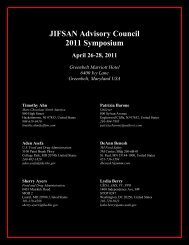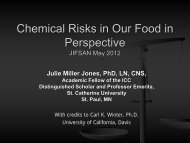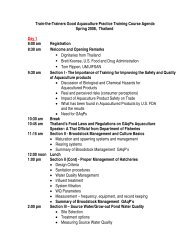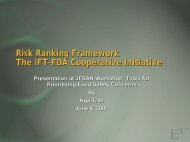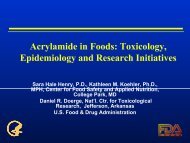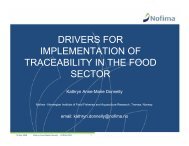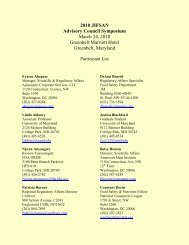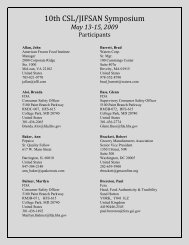PDF(186 KB) - jifsan
PDF(186 KB) - jifsan
PDF(186 KB) - jifsan
You also want an ePaper? Increase the reach of your titles
YUMPU automatically turns print PDFs into web optimized ePapers that Google loves.
JIFSAN Acrylamide Workshop<br />
April 13 – 15, 2004<br />
Chicago, IL<br />
Summary of Working Group 5 - Risk Communication<br />
Chair: Dave Schmidt<br />
Rapporteurs: Joan Rothenberg, Tony Flood<br />
The 2 nd meeting of the Joint Institute for Food Safety and Applied Nutrition (JIFSAN)<br />
Acrylamide Workshop met in Chicago, in April 2004 as a follow-up to the October 2002<br />
acrylamide workshop. The meeting brought together leaders in acrylamide research from<br />
science, academia, international governments and industry to discuss progress over the<br />
past two years and to identify additional areas of research. The six working groups for<br />
the 2004 workshop included: 1.) mechanisms of formation and mitigation options; 2.)<br />
analytical methods of detection; 3.) exposure and biomarkers; 4.) toxicology and<br />
metabolic consequences; 5.) risk communication and 6.) risk characterization.<br />
This workshop demonstrated much significant research has been initiated on a global<br />
basis and important facts and understandings were shared throughout this meeting. From<br />
a communication standpoint it is important to support an open dialogue and collaboration<br />
in acrylamide research efforts globally.<br />
Researchers, institutions, scientists and risk managers are now often called on to report<br />
the research findings regarding acrylamide in food. Good risk communication strategy<br />
can be effective in providing context to complex scientific information for the technical<br />
community, opinion leaders, journalists and consumers.<br />
Participants in the risk communication working group were asked to observe the first<br />
section of each of the other working groups in order to capture information reported that<br />
would be significant to risk communication. Although many of these points were<br />
mentioned in several working groups, the following are highlights from working group<br />
discussions.<br />
Working Group I: Mechanisms of Formation and Methods of Mitigation:<br />
‣ General agreement that the research indicated that the primary mechanisms for<br />
formation involved carbonyl group + asparagine in the presence of heat, leading<br />
to the formation to acrylamide.<br />
‣ Several mitigation techniques including blanching, rinsing and the inclusion of<br />
asparaginase showed the potential to reduce or inhibit the formation or<br />
acrylamide, however, it is important to remember that further research and time<br />
will be required prior to any commercial options available (consumer acceptance,<br />
availability, commercial scalability and adjustments to processes).<br />
‣ It is important to note that with all the techniques reported, further research may<br />
be required to address unintended effects.<br />
JIFSAN Acrylamide Workshop: Summary of Working Group 5 – Risk Communication 1
Working Group II: Analytical Methods of Detection<br />
‣ The analytical chemists expressed confidence that the analytical methods, which<br />
have been developed and proficiency tested are adequate and capture acrylamide<br />
levels in different food items.<br />
‣ May be useful to establish certified reference materials for increased validation of<br />
acrylamide testing.<br />
Working Group III: Exposure and Biomarkers<br />
‣ Exposure analysis demonstrates that elimination of acrylamide from any one food<br />
category or the elimination of that food from the diet would not significantly<br />
reduce the overall exposure of acrylamide in an individual.<br />
‣ Review of epidemiological data does not conclusively support the basis for a link<br />
between acrylamide in food and risk of cancer in humans.<br />
‣ Modifications in food preparation in the home and storage of some foods may<br />
impact acrylamide formation.<br />
‣ Differences in acrylamide formation in food may be the results of variability in<br />
agricultural products (seasonality, soil conditions, variety).<br />
‣ Much progress has been made but still a lot of work is needed in the area of<br />
biomarkers.<br />
Working Group IV: Toxicology and Metabolic Consequences<br />
‣ From a communication standpoint, it is important to understand that the formation<br />
of glycidimide may be crucial for toxicological considerations.<br />
‣ The establishment of good PB / PK models is critical for understanding<br />
acrylamide toxicology.<br />
‣ In animal models the path of administration of acrylamide dose is an important<br />
consideration.<br />
‣ Challenges may lie in finding the most sensitive endpoints; and their effects on<br />
“sensitive” populations.<br />
JIFSAN Acrylamide Workshop: Summary of Working Group 5 – Risk Communication 2
Working Group V: Risk Communication<br />
Questions surrounding risk communication were answered with input from participants<br />
floating to the other working groups. Questions to the working group and answers<br />
discussed are listed below<br />
1. Does the current science on acrylamide in food require any new focus on public<br />
communication What might be needed<br />
a. Provide context on current information<br />
b. Polish existing messages and update appropriately<br />
c. Keep it simple for consumers to understand<br />
2. What new findings presented at the workshop are of potential interest to the lay<br />
public<br />
a. Risk characterization<br />
b. Progress on mitigation – more needs to be done; potentially long term<br />
c. Potential strategies in the home to avoid over-browning of foods. The<br />
importance of time- temperature in heating. More research is needed.<br />
3. Do any findings present unique challenges for public communication<br />
a. No, but some general uncertainties may require forethought in future<br />
communication strategy<br />
4. Does a risk communication analysis indicate any adjustment to public<br />
communication needs<br />
a. Generally no, but . . . opportunities to strengthen global collaboration and<br />
information sharing exist<br />
b. Risk / Benefit messages need to be considered<br />
5. Is additional consumer attitude research necessary to gauge public awareness of<br />
concern about acrylamide in food Of the remaining research needs, which is the<br />
highest priority<br />
a. No additional consumer research is needed but it would be in our best<br />
interest to retain the option depending on trends in consumer awareness<br />
and media interest<br />
Working Group VI: Risk Characterization<br />
‣ Risk characterization can be defined as the convergence of risk identification, risk<br />
quantification and understanding uncertainties / knowledge gaps<br />
‣ Important for decision makers<br />
‣ “If we fix the acrylamide problem is it better or worse for consumers”<br />
‣ The risk of neurotoxicity is negligible<br />
‣ Challenges remain in identifying the most susceptible populations . . . other than<br />
age class<br />
‣ Context is important to describe the impact of uncertainty (this is what we’ve<br />
learned, this is what we still need to know); progress – uncertainty<br />
JIFSAN Acrylamide Workshop: Summary of Working Group 5 – Risk Communication 3
Working Group 5 – Risk Communication<br />
“There’s a kind of hush all over the world, but . .<br />
we need to be prepared on all fronts”<br />
This statement characterizes the current climate of media response to acrylamide as<br />
evidenced by the IFIC media-monitoring chart below:<br />
Number of<br />
Articles<br />
100<br />
90<br />
80<br />
70<br />
60<br />
50<br />
40<br />
30<br />
20<br />
10<br />
0<br />
Jan-Mar<br />
02<br />
Turnquist presentation in Sweden<br />
Apr-Jun<br />
02<br />
Jul-Sep<br />
02<br />
Oct-Dec<br />
02<br />
FDA Data<br />
Jan-Mar<br />
03<br />
Apr-Jun<br />
03<br />
Intl Research and<br />
Prop 65<br />
Jul-Sep<br />
03<br />
Oct-Dec<br />
03<br />
ACS mtg, FDA<br />
data Harvard study<br />
Jan-Mar<br />
04<br />
Recommendations from Working Group 5 include:<br />
‣ Develop and distribute transparent meeting summary to interested parties on a<br />
timely basis<br />
‣ Ongoing monitoring of this issue will help avoid surprises<br />
‣ Characterize the global (research and international collaboration) effort that has<br />
been put forth thus far and how it is likely to continue beyond the acrylamide<br />
issue. This will help reassure the public of a credible research agenda; such<br />
patience will yield solid scientific results.<br />
June 2004<br />
JIFSAN Acrylamide Workshop: Summary of Working Group 5 – Risk Communication 4





